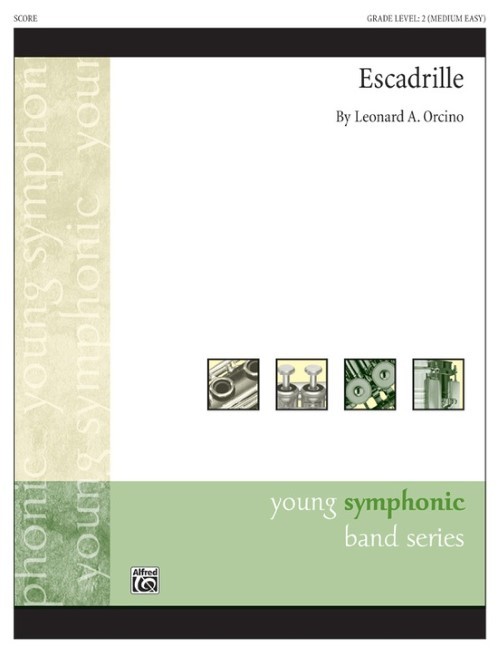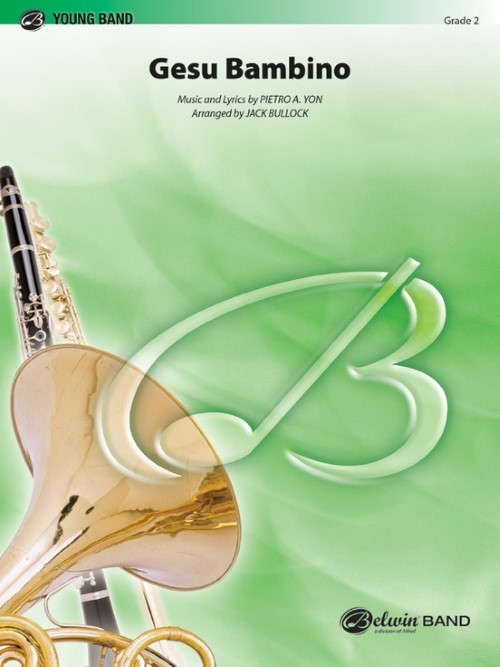Results
-
£54.99
The Independent - A. Buglione
Note: This is a reprint from a vintage publication of 1902. No conductor score is published for this work. The Solo Cornet part serves as a conductor guide.Due to the era of this work, saxophone and double-reed parts are not published. Parts for Eb Horns are included; no F Horn parts are published for this work. If a C Piccolo/C Flute part was not published originally, one has been subsequently added by our editorial staff.
Estimated dispatch 7-14 working days
-
£54.99
May Flower - A. Buglione
Note: This is a reprint from a vintage publication of 1902. No conductor score is published for this work. The Solo Cornet part serves as a conductor guide.Due to the era of this work, saxophone and double-reed parts are not published. Parts for Eb Horns are included; no F Horn parts are published for this work. If a C Piccolo/C Flute part was not published originally, one has been subsequently added by our editorial staff.
Estimated dispatch 7-14 working days
-
£54.99
Ave Maria - A. Buglione
Note: This is a reprint from a vintage publication of 1903. No conductor score is published for this work. The Solo Cornet part serves as a conductor guide.Due to the era of this work, saxophone and double-reed parts are not published. Parts for Eb Horns are included; no F Horn parts are published for this work. If a C Piccolo/C Flute part was not published originally, one has been subsequently added by our editorial staff.
Estimated dispatch 7-14 working days
-
£54.99
Our Friends - A. Buglione
Note: This is a reprint from a vintage publication of 1903. No conductor score is published for this work. The Solo Cornet part serves as a conductor guide.Due to the era of this work, saxophone parts are not published. Parts for Eb Horns are included; no F Horn parts are published for this work. If a C Piccolo/C Flute part was not published originally, one has been subsequently added by our editorial staff.
Estimated dispatch 7-14 working days
-
£54.99
C.E.K. - A. Buglione
Note: This is a reprint from a vintage publication of 1904. No conductor score is published for this work. The Solo Cornet part serves as a conductor guide.Due to the era of this work, saxophone parts are not published. Parts for Eb Horns are included; no F Horn parts are published for this work. If a C Piccolo/C Flute part was not published originally, one has been subsequently added by our editorial staff.
Estimated dispatch 7-14 working days
-
 £52.95
£52.95Escadrille (Concert Band - Score and Parts) - Orcino, Leonard A.
Early in World War I (1916), prior to the USA entering the conflict, Americans joined the French Air Corps. They were originally called the Escadrille Americaine and the name was changed to Escadrille de Lafayette after protest from the Germans that America was not in the war. The Escadrille had a reputation for daring recklessness and a party atmosphere. The corps mascots were two lion cubs, Whiskey and Soda. The insignia was an American Indian head with a flowing war bonnet. The entire squadron merged with the American Air corps (1918) once the USA entered the war.Duration: 2.30
Estimated dispatch 7-14 working days
-
 £54.99
£54.99Emoji Festival - Jerry A. West
These delightful ideograms have become a standard feature of everyday life! They show up everywhere, so why not on your beginning musicians concert programs? This lighthearted and upbeat music reflects the fun aspect of these memorable characters and is sure to captivate your young players and their audiences.
Estimated dispatch 7-14 working days
-
 £58.50
£58.50Gesu Bambino (Concert Band - Score and Parts) - Yon, Pietro A. - Bullock, Jack
This charming Italian carol will not only be well received on any Christmas programme, but also reinforce triple-meter and DS al Coda form, phrasing, and ensemble balance. An endearing musical choice!Duration: 2:30
Estimated dispatch 7-14 working days
-
£137.99
Odyssee Wind Band Set (Score & Parts)
The Odyssee tells the story of Odysseus, the undaunted hero. In times long ago the blind poet Homer wrote this famous epic. The "Odyssey" follows the "Iliad", the story of the bloody war between the Greek and the Trojans. This battle ends after ten years thanks to the Odysseys famous trick. the Trojan Horse. The Odyssey is not a war epic, but a story about perseverance, loyalty, adventure, and the survival instinct of its ingenious hero. In The Odyssey, Homer describes how Odysseus, the king of Ithaca, had to endure another ten years of affliction after the ten years of war in Troy before he could finally return to his home land. During those years, his wife, Penelope, had to try and keep her many admirers away. These men not only wanted het hand but also the kingship. To prove her husbands worth, she played a trick: "As soon as I have finished weaving this shroud for my father-in-law, Laertes, I will choose one of you to become my husband", she promised them. But during the night, she secretly loosened what she had woven during the day, prolonging the time until Odysseus would finally return. After twenty long years, when he finally stood at the door, she wondered: Is this really my husband? Is he an imposter? Cunningly, she asked him to move the bed, because only she and her husband know that the bed was immovable and was build around an old three trunk! Odysseus was deeply moved: this really was his wife, his Penelope! Nearly three thousands years later, the loyalty and strength of this character, and all the dangerous adventures that Odysseus survived thanks to courage and intelligence, still moves us today. Odyssee by Jan Bosveld is not just an adventure story, but rather a characteristic piece in which memories of Homers story can be heard. The composition opens with a firm, stirring theme describing our hero, Odysseus, in detail: This man is not to be taken lightly. The further development of this short introduction completes this character sketch: trustworthy, perseverant, and a genius. After that we can picture Odysseus on the lonely beach of Ogygia. Do the trumpets depict his memories of the war of Troy? Does he think of his wife, as we recognise the weaving loom of Penelope in the murmuring eighth? In the solemn, plaintive part that follows, we can imagine Penelope feeling lonely, sitting in the womens room with her servants.One of the girls plays the harp, but that does not clear the sombre atmosphere. Then we can imagine seeing the sorceress Circe, who changed Odysseus men into swine. After she gives a simple magic sign something follows that reminds us of the sound of pigs grunting. Then the Odysseus theme resounds: the hero comes to savi his comrades. Assisted by Hermes, he forces Circe to lift the spell. The piece ends the same way as it began, with an animated theme: Odysseus is still the same, undefeated and not to be taken lighty! 07:45
Estimated dispatch 7-14 working days
-
 £137.99
£137.99Odyssee - Jan Bosveld
The Odyssee tells the story of Odysseus, the undaunted hero. In times long ago the blind poet Homer wrote this famous epic. The "Odyssey" follows the "Iliad", the story of the bloody war between the Greek and the Trojans. This battle endsafter ten years thanks to the Odysseys famous trick. the Trojan Horse. The Odyssey is not a war epic, but a story about perseverance, loyalty, adventure, and the survival instinct of its ingenious hero. In The Odyssey, Homer describes howOdysseus, the king of Ithaca, had to endure another ten years of affliction after the ten years of war in Troy before he could finally return to his home land. During those years, his wife, Penelope, had to try and keep her many admirers away.These men not only wanted het hand but also the kingship. To prove her husbands worth, she played a trick: "As soon as I have finished weaving this shroud for my father-in-law, Laertes, I will choose one of you to become my husband", she promisedthem. But during the night, she secretly loosened what she had woven during the day, prolonging the time until Odysseus would finally return. After twenty long years, when he finally stood at the door, she wondered: Is this really my husband? Ishe an imposter? Cunningly, she asked him to move the bed, because only she and her husband know that the bed was immovable and was build around an old three trunk! Odysseus was deeply moved: this really was his wife, his Penelope! Nearly threethousands years later, the loyalty and strength of this character, and all the dangerous adventures that Odysseus survived thanks to courage and intelligence, still moves us today. Odyssee by Jan Bosveld is not just an adventure story, butrather a characteristic piece in which memories of Homers story can be heard. The composition opens with a firm, stirring theme describing our hero, Odysseus, in detail: This man is not to be taken lightly. The further development of thisshort introduction completes this character sketch: trustworthy, perseverant, and a genius. After that we can picture Odysseus on the lonely beach of Ogygia. Do the trumpets depict his memories of the war of Troy? Does he think of his wife, as werecognise the weaving loom of Penelope in the murmuring eighth? In the solemn, plaintive part that follows, we can imagine Penelope feeling lonely, sitting in the womens room with her servants.One of the girls plays the harp, but that does notclear the sombre atmosphere. Then we can imagine seeing the sorceress Circe, who changed Odysseus men into swine. After she gives a simple magic sign something follows that reminds us of the sound of pigs grunting. Then the Odysseus theme resounds:the hero comes to savi his comrades. Assisted by Hermes, he forces Circe to lift the spell. The piece ends the same way as it began, with an animated theme: Odysseus is still the same, undefeated and not to be taken lighty!
Estimated dispatch 7-14 working days
